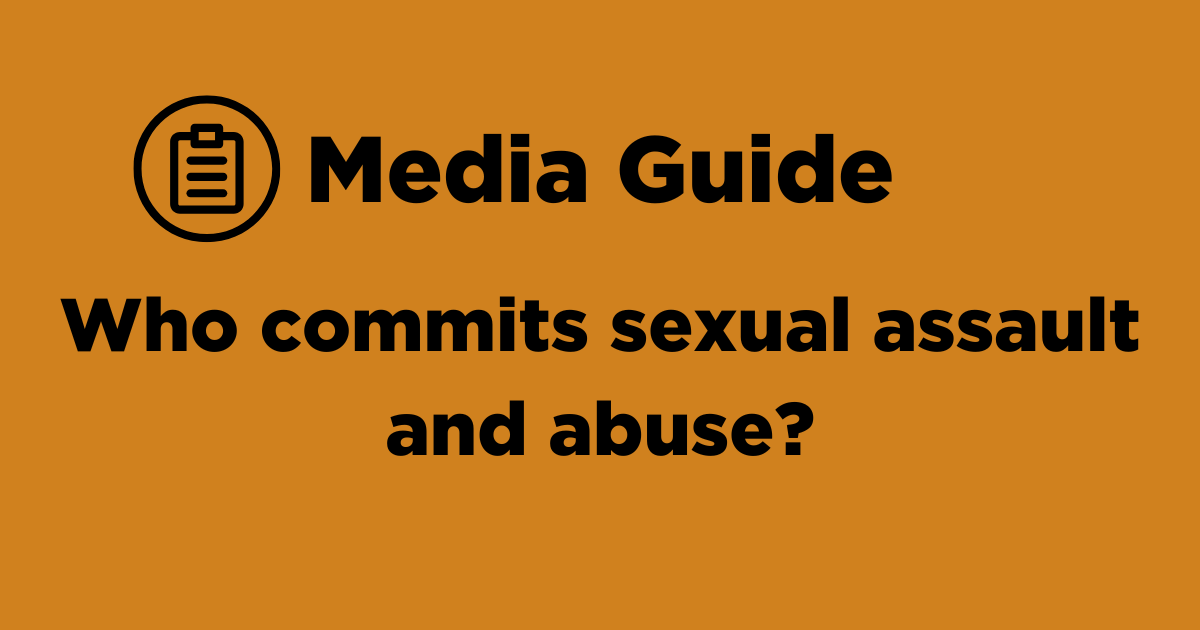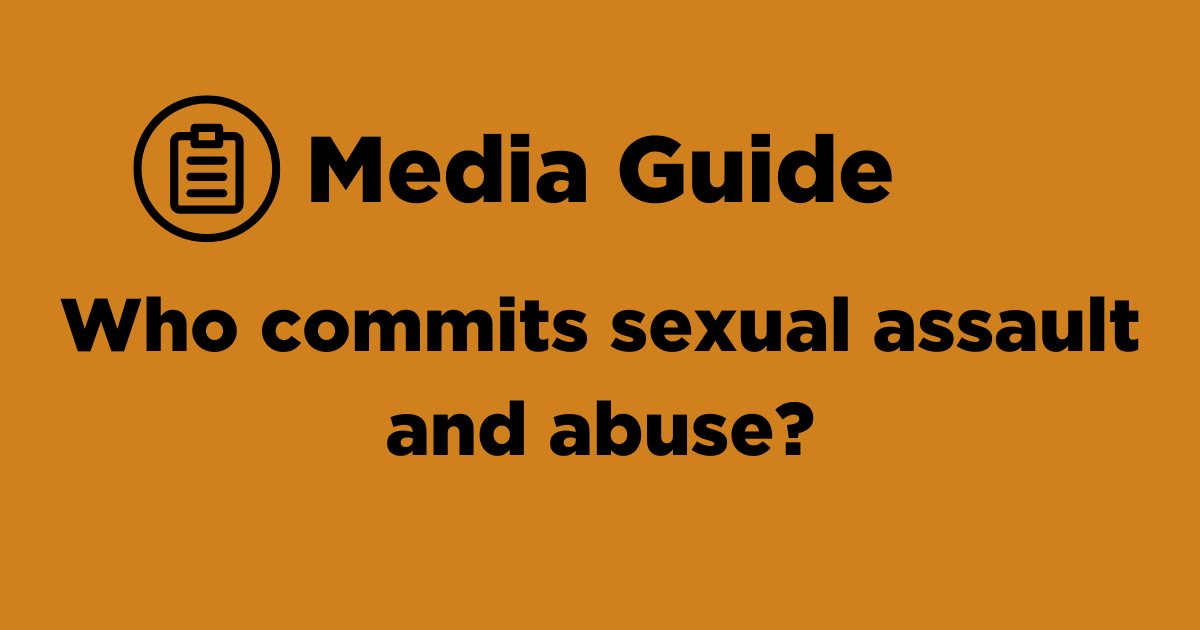
 Sexual violence is any sexual act where consent is not obtained or freely given. To understand and report on the broader context of sexual assault, harassment, and abuse, we must recognize who commits these acts and how they are held accountable. Crime dramas and media portrayals of sexual assault focus on dealing with people who commit sexual abuse through the criminal justice system. But this system will not encounter most people who commit sexual assault. We know that many people who commit sexual assault or abuse are not caught, charged, or held accountable — over 66% of sexual assaults are not reported to police, and many cases that are reported do not make it to court.1
Sexual violence is any sexual act where consent is not obtained or freely given. To understand and report on the broader context of sexual assault, harassment, and abuse, we must recognize who commits these acts and how they are held accountable. Crime dramas and media portrayals of sexual assault focus on dealing with people who commit sexual abuse through the criminal justice system. But this system will not encounter most people who commit sexual assault. We know that many people who commit sexual assault or abuse are not caught, charged, or held accountable — over 66% of sexual assaults are not reported to police, and many cases that are reported do not make it to court.1
While it is important to hold people who cause harm accountable, prosecution is just one way that society can prevent and respond to sexual violence. It is also crucial for communities to address the risk factors that make people more likely to commit sexual abuse in the first place. Some communities are also taking a restorative justice approach to address sexual assault and abuse.
Refer to Sexual Violence Prevention: Resource For Action to learn how communities can take advantage of the best available evidence to prevent sexual violence from happening in the first place.
How to talk about people who sexually abuse
The way we talk about people who sexually abuse others matters. Often, people who commit sexual abuse are portrayed publicly as “monsters.” Because of this, people might be less likely to recognize the warning signs of a sexual behavior problem in loved ones or others with whom they are close.2 Someone who suspects abuse within a family could be less likely to ask for help, as they may not want to subject their family members to public attention and scorn.3
One way to avoid dehumanizing terms in your reporting is to use person-first language wherever possible. Instead of saying “perpetrator,” you can use a phrase like “the person who committed sexual assault.” Using person-first language allows you to focus on the actions of the person rather than labeling them.
The facts about people who sexually abuse
There are common misconceptions and stereotypes about people who sexually abuse. Stereotypes reinforced in media coverage add to misinformation. Here are some facts about people who sexually abuse:
- The majority of sexual harassment, assault, and abuse is committed by someone the victim knows — a family member, intimate partner, coworker, classmate, or acquaintance.4
- Not all people who sexually abuse are the same. Some are more likely to reoffend than others, and they have many different motivations. You cannot tell whether someone is likely to commit sexual abuse just by looking at them.5
- People who sexually abuse can have strong social ties in the community and may have stable relationships, jobs, and no prior criminal history. They may use their standing as a celebrity, their authority status, or their trusted position to abuse.
- While the majority of the people who perpetrate sexual violence are men6, people who sexually abuse can be any gender identity, background, or age7.
Risk factors
Various individual, relationship, community, and societal factors can increase or decrease the likelihood that someone will sexually abuse. The presence of risk factors does not mean that abusive behaviors will happen. Understanding these risk factors creates opportunities to identify effective prevention strategies.8 Risk factors for sexual violence perpetration include9:
Individual Risk Factors
- Alcohol and drug use
- Lack of concern for others
- Aggressive behaviors and acceptance of violent behaviors
- Exposure to sexually explicit media
- Hostility toward women
- Adherence to traditional gender role norms
- Hyper-masculinity
Relationship Factors
- Family history of conflict or violence
- Childhood history of physical, sexual or emotional abuse
- Involvement in violence or abuse relationships
Community Factors
- Poverty
- Lack of employment opportunities
- Lack of institutional support from police and judicial system
Societal Factors
- Norms that support sexual violence
- Norms that support male superiority and sexual entitlement
- Norms that maintain women’s inferiority and sexual submissiveness
- Weak laws and policies related to sexual violence and gender equality
Learn more about Sexual Violence Prevention: Risk and Protective Factors.
Accountability
Stories about people who commit sexual harassment, assault, and abuse tend to focus on how they were punished by the criminal justice system. However, most cases of sexual assault do not go through the court system. Discussing the limitations of the criminal justice system in handling and preventing sexual assault can help readers understand the need for systems that effectively respond to and prevent sexual harassment, abuse, and assault. Accountability is a concept you can cover in your reporting, even if a case does not make it to court.
Criminal justice system
Once a convicted abuser returns to the community, they are often placed on their state’s sex offender registry. The resulting housing and job instability, loss of income, stigma of being on a registry, and isolation could increase their risk of reoffending10. Restrictions on where someone is allowed to live after a conviction may force people out of communities where they have support networks into areas where they do not have the support they need, which could lead to reoffending11. Overall, there is very little evidence that sex offender registries prevent sexual violence12.
Children with sexual behavior problems are also often placed on sex offender registries, a stigma that follows them for the rest of their lives and gives them little chance to get off the registry. Being on a sex offender registry as a child can lead to psychological harm, physical violence, and inability to find a job or place to live13. The truth is that youth who abuse other children often do not reoffend, and they are generally very receptive to treatment14.
Restorative & transformative justice
Many survivors know and have personal relationships with the person who sexually assaulted them. This means they may choose not to enter the criminal justice system for a number of reasons, including:
- They depend financially on the person who assaulted them
- They love or care about the person who assaulted them
- They may not feel safe interacting with police
Justice and accountability in sexual assault cases can take place outside the criminal justice system. In recognition of the systemic racism and injustice in the criminal justice system, communities have also looked to alternative approaches of justice, including restorative and transformative justice15.
Learn more about alternative forms of justice here:
- What is restorative justice?
- What is transformative justice?
- Transformative Justice Resource Compilation
1Morgan, R. E., & Truman, J. L. (2020, September). Criminal victimization, 2019 (NCJ 255113). U.S. Department of Justice, Bureau of Justice Statistics. https://bjs.ojp.gov/content/pub/pdf/cv19.pdf
2Tabachnick, J., & Klein A. (2011). A reasoned approach: Reshaping sex offender policy to prevent child sexual abuse. Association for the Treatment of Sexual Abusers.
http://www.atsa.com/pdfs/ppReasonedApproach.pdf
3Tabachnick, J., & Klein A. op. cit.
4Peterson, C., Liu, Y., Merrick, M., Basile, K. C., & Simon, T. R. (2019). Lifetime number of perpetrators and victim-offender status per U.S. victim of intimate partner, sexual violence, or stalking. Journal of Interpersonal Violence, 36(13-14), NP7284–NP7297. https://doi.org/10.1177/0886260518824648
5Association for the Treatment of Sexual Abusers. (2014). Eight things everyone should know about sexual abuse & sexual offending. https://www.atsa.com/pdfs/Policy/8ThingsEveryoneShouldKnow.pdf
6Smith, S. G., Chen, J., Basile, K. C., Gilbert, L. K., Merrick, M. T., Patel, N., Walling, M., & Jain, A. (2017). The National Intimate Partner and Sexual Violence Survey (NISVS): 2010-2012 state report. U.S. Department of Health & Human Services, Centers for Disease Control and Prevention. https://www.cdc.gov/violenceprevention/pdf/NISVS-StateReportBook.pdf
7Association for the Treatment of Sexual Abusers. op. cit.
8Centers for Disease Control and Prevention. (n.d.). Risk and protective factors [Webpage]. U.S. Department of Health & Human Services. https://www.cdc.gov/sexual-violence/risk-factors/index.html
9Tharp, A. T., DeGue, S., Valle, L. A., Brookmeyer, K. A., Massetti, G. M., & Matjasko, J. L. (2013). A systematic qualitative review of risk and protective factors for sexual violence perpetration. Trauma, Violence, & Abuse, 14(2), 133-167. https://doi.org/10.1177/1524838012470031
10Tabachnick, J., & Klein A. op. cit.
11Jacobs, D. (n.d.). Why sex offender laws do more harm than good. ACLU New Jersey. https://www.aclu-nj.org/theissues/criminaljustice/whysexoffenderlawsdomoreha
12Human Rights Watch. (2007). US: Sex offender laws may do more harm than good. https://www.hrw.org/news/2007/09/11/us-sex-offender-laws-may-do-more-harm-good
13Pittman, N., and Parker, A. (2013). Raised on the registry: The irreparable harm of placing children on sex offender registries in the US. Human Rights Watch. https://www.hrw.org/report/2013/05/01/raised-registry/irreparable-harm-placing-children-sex-offender-registries-us#
14National Juvenile Justice Network. (2014). Youth who commit sex offenses: Research update. https://www.njjn.org/uploads/digital-library/Registries-Youth-Who-Commit-Sex-Offenses_Nov2014.pdf?phpMyAdmin=14730ab3483c51c94ca868bccffa06ef
15American Civil Liberties Union. (n.d.). Racial justice [Webpage]. https://www.aclu.org/issues/racial-justice#current

